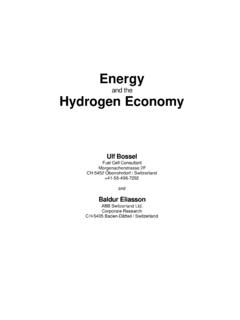Transcription of Lazard’s Levelized Cost of Storage Analysis—Version 6
1 L A Z A R D S L E V E L I Z E D C O S T O F S TO R A G E A N A LY S I S V E R S I O N 6 . 0 Table of Contents IINTRODUCTION1 IILAZARD S Levelized COST OF Storage ANALYSIS Storage VALUE SNAPSHOT ANALYSIS7 IVPRELIMINARY VIEWS ON LONG-DURATION STORAGE11 APPENDIXAS upplemental LCOS Analysis Materials14 BValue Snapshot Case Studies1 Value Snapshot Case Studies Snapshot Case Studies International23 CSupplemental Value Snapshot Analysis Materials25 IIntroductionCopyright 2020 Lazard This study has been prepared by Lazard for general informational purposes only, and it is not intended to be, and should not be construed as, financial or other advice. No part of this material may be copied, photocopied or duplicated in any form by any means or redistributed without the prior consent of Lazard s Levelized Cost of Storage ( LCOS ) analysis(1) addresses the following topics.
2 Introduction A summary of key findings from Lazard s Lazard s LCOS analysis Overview of the operational parameters of selected energy Storage systems for each use case analyzed Comparative LCOS analysis for various energy Storage systems on a $/kW-year and $/MWh basis energy Storage Value Snapshot analysis Overview of the Value Snapshot analysis and identification of selected geographies for each use case analyzed Summary results from the Value Snapshot analysis A preliminary view of long-duration Storage technologies Selected appendix materials Supplementary materials for Lazard s LCOS analysis, including methodology and key assumptions employed Supporting materials for the Value Snapshot analysis, including pro forma results for the and International Value Snapshot case studies Supplementary materials for the Value Snapshot analysis, including additional informational regarding the revenue streams available to each use caseSource: Lazard and Roland Berger.
3 (1)Lazard s LCOS analysis is conducted with support from Enovation Analytics and Roland I N T R O D U C T I O N1 Copyright 2020 Lazard This study has been prepared by Lazard for general informational purposes only, and it is not intended to be, and should not be construed as, financial or other advice. No part of this material may be copied, photocopied or duplicated in any form by any means or redistributed without the prior consent of Lithium-ion chemistries continue to be the dominant Storage technology for short-duration applications ( , 1 4 hours), representing ~90% of the market Competing technologies are less attractive for most applications given Lithium-ion s advantages in commercial acceptance, price, energy density and availability Momentum in the energy Storage market favors Lithium Iron Phosphate ( LFP )
4 Manufacturers, whose Storage modules are less expensive and considered a potentially safer technology given higher temperature thresholds for thermal runaway LFP slower volumetric energy density is not viewed as overly detrimental for most stationary Storage use cases Segments of the vehicle market are also adopting LFP, creating the potential for continued scale benefits from EV adoption Interest in long-duration Storage solutions is growing as more projects reach pilot stages Ideal applications currently include resilience, resource adequacy and capacity services, albeit concerns pertaining to round-trip efficiency and O&Mpersist OEMs are focused on areas with potentially significant curtailment of renewable energy , ( , the , Europe and South America), as well as resilience-related needs in California ( , SDG&E sCameron Corners project) Corporate customers and utility companies are also evaluating these technologies to satisfy long-term carbon reduction goals Developers prefer to benchmark technology and project costs against natural gas peakersvs.
5 Other short-duration Storage technologies, ( , Lithium-ion)Use Cases The economic proposition of C&I behind-the-meter ( BTM ) projects remains challenged without subsidies Time-of-Use ( TOU ) arbitrage is typically insufficient on its own to produce favorable economics for C&I BTMuses, and demand charge and demand response ( DR ) revenues are sufficient only in a subset of markets ( , California and New York) In select cases, the value proposition for C&I BTMstorage appears to be shifting towards power reliability and resilience applications, with TOUarbitrage as a secondary benefit Demand for PV+Storageuse cases is primarily driven by utility procurements and the forthcoming step-down of the ITC PV+Storageprojects are becoming increasingly price competitive as utilities look for ways to supplement retiring conventional generation resources while avoiding investments in new peaking power plants Demand for PV+Storageplants is also being enhanced by the desire to lock in favorable economics prior to the step-down of the ITC, as well as increased Independent System Operator ( ISO )
6 Sensitivity to intermittency as renewables penetration grows The parameters associated with the ITC are leading developers to favor oversizing the initial system capacity vs. augmenting it over time as the Storage modules degradeSummary of Key Findings & Observed Trends in the energy Storage IndustryI I N T R O D U C T I O N2 IILazard s Levelized Cost of Storage Analysis 2020 Lazard This study has been prepared by Lazard for general informational purposes only, and it is not intended to be, and should not be construed as, financial or other advice. No part of this material may be copied, photocopied or duplicated in any form by any means or redistributed without the prior consent of Storage Use Cases OverviewBy identifying and evaluating the most commonly deployed energy Storage applications, Lazard s LCOS analyzes the cost and value of energy Storage use cases on the grid and behind-the-meterUse Case DescriptionTechnologies AssessedIn-Front-of-the-MeterWholesale Large-scale energy Storage system designed for rapid start and precise following of dispatch signal.
7 Variations in system discharge duration are designed to meet varying system needs ( , short-duration frequency regulation, longer-duration energy arbitrage(1)or capacity, etc.) To better reflect current market trends, this report analyzes one-, two-and four-hour durations(2) Lithium Iron Phosphate Lithium Nickel Manganese Cobalt Oxide Transmission and Distribution energy Storage system designed to defer or avoid transmission and/or distribution upgrades, typically placed at substations or distribution feeders controlled by utilities to provide flexible capacity while also maintaining grid stability Lithium Iron Phosphate Lithium Nickel Manganese Cobalt Oxide Flow Battery Vanadium Flow Battery Zinc Bromine Flow Battery Copper ZincWholesale(PV+ Storage )
8 energy Storage system designed to be paired with large solar PV facilities to better align timing of PV generation with system demand, reduce solar curtailment and provide grid support Lithium Iron Phosphate Lithium Nickel Manganese Cobalt Oxide Flow Battery Vanadium Flow Battery Zinc Bromine Flow Battery Copper ZincBehind-the-MeterCommercial & Industrial (Standalone) energy Storage system designed for behind-the-meter peak shaving and demand charge reduction for C&I energy users Units often configured to support multiple commercial energy management strategies and provide optionality for the system to provide grid services to a utility or the wholesale market, as appropriate in a given region Lithium Iron Phosphate Lithium Nickel Manganese Cobalt Oxide Flow Battery Vanadium Flow Battery Zinc Bromine Flow Battery Copper ZincCommercial & Industrial (PV+ Storage )
9 energy Storage system designed for behind-the-meter peak shaving and demand charge reduction services for C&I energy users Systems designed to maximize the value of the solar PV system by optimizing available revenues streams and subsidies Lithium Iron Phosphate Lithium Nickel Manganese Cobalt Oxide Flow Battery Vanadium Flow Battery Zinc Bromine Flow Battery Copper ZincResidential(PV+ Storage ) energy Storage system designed for behind-the-meter residential home use provides backup power, power quality improvements and extends usefulness of self-generation ( , PV+ Storage ) Regulates the power supply and smooths the quantity of electricity sold back to the grid from distributed PV applications Lithium Iron Phosphate Lithium Nickel Manganese Cobalt Oxide123456I I L A Z A R D S L E V E L I Z E D C O S T O F S T O R A G E A N A L Y S I S V 6.
10 0 Source:Industry interviews, Lazard and Roland Berger. Note:Use case numbering shown above serves as an identifier for the corresponding individual use cases discussed on subsequent pages.(1)For the purposes of this analysis, energy arbitrage in the context of Storage systems paired with solar PV includes revenuestreams associated with the sale of excess generation from the solar PV system, as appropriate, for a given use case.(2)The Value Snapshot analysis only evaluates the four-hour wholesale use case. 3 Copyright 2020 Lazard This study has been prepared by Lazard for general informational purposes only, and it is not intended to be, and should not be construed as, financial or other advice. No part of this material may be copied, photocopied or duplicated in any form by any means or redistributed without the prior consent of Storage Use Cases Illustrative Operational ParametersI I L A Z A R D S L E V E L I Z E D C O S T O F S T O R A G E A N A L Y S I S V 6.


![[Logo To Come] - Lazard](/cache/preview/b/e/f/6/9/1/8/9/thumb-bef691898073c3588972f362b9ac0cd8.jpg)









